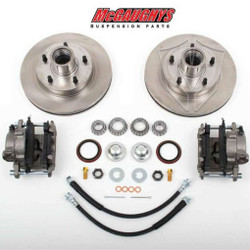So you've got yourself a car, truck or SUV. It's probably got brakes, right? We'd hope so. But a lot of vehicle owners don't know what kind of brakes they have slowing down their passengers. And it's kind of important, because the two options — drum brakes and disc brakes — operate very differently. Let's get into it.
A little bit about drum brakes.
Drum brakes were the brake option of choice back in the 1960s and before, and were put on all four corners of the vehicle. The idea here is that you have a drum — a barrel-shaped shell that goes over your wheel studs — and inside of it are brake shoes. When you push down on the brake pedal, hydraulic pressure from the brake master cylinder causes the shoes to extend outwards, applying pressure on the drums. The resulting friction slows down the car or truck until you stop.
Now drum brakes are fine, but they're not the most efficient method out there. That's because repeated use causes them to heat up, which can cause brake fade — a condition where your brakes don't operate as efficiently as they could. This can be dangerous. After all, when you hit the pedal you expect your ride to stop, and if it doesn't — or doesn't in the space you've allotted — you could be in for a bad afternoon.
Drum brakes used to be standard on all four corners, but recently they've been relegated to rear-end duty. You'll often find drum brakes on the rear of vehicles, particularly if they're more than 10 years old.
What were they replaced with? Well ...
Let's talk about disc brakes.
Disc brakes came into play more in the 1970s. Here, the system is similar but different. Now you have a rotor that rotates (naturally) around the hub on your suspension. The rotor has a brake caliper placed over it, and brake pads are inside of the brake caliper. When you push down on the pedal the same basic function happens as it does with drum brakes, but now the caliper closes, clamping the brake pads onto the rotors.
This is a more efficient system for a number of reasons, the main one being heat. The rotor is exposed to the air, and so when all that friction builds up all that heat, it needs to go somewhere. Disc brakes help with that and minimize (but not eliminate) brake fade.
On the downside, they do require more pressure to operate. While you can use a brake master cylinder without a brake booster, it's not a lot of fun. The additional pressure provided by the brake booster makes your life a lot easier, so if you're converting from drums to discs, don't forget the booster.
We've got you covered.
Now whether you have drums or discs, we've got you covered. We even have a wide variety of rear disc brake kits if you want to convert your drum-brake equipped ride. No matter what you're looking for, give us a call or check out the site and we'll help you out.




 800-928-1984
800-928-1984



